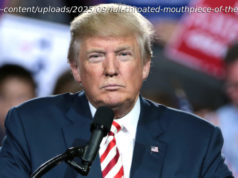Hint: You don’t need to worry that much.
A cruise missile, powered by nuclear technology, that can reach the United States. Nuclear weapons that can evade any missile defense system. Unstoppable drone submarines that can be used to blow up foreign ports.
Those are the weapons Russian President Vladimir Putin claims he now has. If true, Putin has purposefully raised the stakes in the decades-long nuclear standoff between Washington and Moscow — threatening to worsen deteriorating ties between Russia and the West.
Putin spent much of his annual state of the nation speech on Thursday talking about Russia’s improving weapons arsenal. He even went so far as to show a video of nuclear missiles striking Florida.
Experts say the most impressive new weapon he revealed is a nuclear-powered cruise missile that can hit any point on Earth. (That’s big: conventional cruise missiles rarely travel more than 600 miles.) This kind of weapon moves so quickly and flies so low to the ground that it could evade US and European missile defense systems and hit intended targets with a nuclear weapon. Putin said this new technology renders American missile defense “useless,” but US officials still say it needs further testing and is not yet operational.
The Defense Department sees it differently. “We’re not surprised by [Putin’s] statements,” top Pentagon spokesperson Dana White told reporters on Thursday, “and the American people should rest assured that we are fully prepared.”
Putin framed the two-hour address as a show of Russian might and defiance against efforts by the West — particularly the United States and NATO — to push back on Moscow. “You have failed to contain Russia,” he said.
But the bellicose language comes at a peculiar time: Russia’s presidential elections are on March 18, just 17 days away. Putin is likely to win a fourth term due to a rigged vote, meaning he could rule Russia until at least 2024. Ahead of the planned victory, he wants to prove to the Russian people he remains fit to lead after nearly 20 years in power, experts say.
“For Putin, it’s all domestic,” says Alina Polyakova, a Russia expert at the Brookings Institution, a think tank in Washington, DC. “The regime needs to constantly maintain its fear-mongering that the US and NATO are out to get Russia and that Putin personally can protect the Russian people.”
So while the new weapons are scary, they’re mostly meant as a signal to Putin’s domestic audience and foes abroad that Russia is strong — and cannot be ignored in the Putin era.
“Nobody listened to us,” Putin said in his speech. “Well, listen to us now.”
Since he first took power in 2000, Putin — who once called the fall of the Soviet Union “the greatest geopolitical catastrophe of the century” — has aimed to restore Russia’s might on the world stage. Building up Russia’s military forms part of that effort, experts say, and having an “enemy” helps justify Putin’s plan to spend around $360 billion between 2011 and 2025 to do that.
“He’s revived the Cold War worldview,” says Polyakova. “The West is the enemy, the US is the enemy,” and that language “serves as a ‘Russia is great again’ narrative on the election stage.”
That helps explain why Putin was so aggressive toward the West during his Thursday address: It makes Russia seem tough thanks to his leadership. But that kind of rhetoric wasn’t an anomaly — it’s just how Russian leaders talk these days.
Just one day before Putin’s remarks, Russian Foreign Minister Sergei Lavrov told a UN conference that the US helps Europe prepare for nuclear strikes on Russia. “Non-nuclear states plan and take part in the US exercises and learn how to use the nuclear weapons,” he said, adding that the US having nuclear weapons in Europe “is not only a rudiment of the Cold War but an openly aggressive position.”
It’s widely believed the US has at least 20 nuclear weapons in Germany, but US officials consistently decline to confirm that. The US has also placed multiple missile defense systems in Eastern Europe, including in Romania, worrying Russia that Western powers threaten its territory. However, there is no indication America has plans to bomb Russia anytime soon.
But Russia certainly worries about America’s nuclear weapons, especially after the US released a new Nuclear Posture Review (NPR) in February. The Pentagon report details America’s desire to develop newer and smaller nuclear bombs, in part to make them more usable.
That, the administration’s argument goes, might deter further Russian aggression. Recall that Moscow actively works to destabilize Western democracies with sophisticated online campaigns to tilt elections toward Moscow-friendly leaders and political parties. It also conducts large-scale military exercises near NATO territory, threatening European countries in the Baltics, or even non-NATO counties like Moldova or Sweden. And Russia still retains control of Crimea, which it seized in 2014, and remains in Ukraine to this day.
Russia-watchers say Putin likely had the NPR in mind when delivering his speech. “I bet it was an indirect response to the NPR,” a senior Senate aide who focuses on defense tells me, but the main goal was “to bolster himself in front of Russia and respond to the US.”
So it looks like Putin chose to answer America’s desire for new weapons with his own weapons display. Now the question is: How much do Putin’s new weapons threaten the US and its allies?
Putin’s missiles are frightening on their face, but they don’t really change the dynamics of the current US-Russia standoff.
Take, for example, the nuclear-powered cruise missile. If Russia does have it, then it would be the first country to create one. (The US tried to develop one in an experimental program called Project Pluto during the Cold War, but it didn’t work out.)
The cruise missile could likely evade US missile defenses with greater success partly because of how agile it is. But Russia’s more conventional, nuclear-tipped missiles can already slip through America’s defenses. “It’s a bit of overkill on their part as their missiles already would have given our missiles defenses trouble,” says Peter Singer, a weapons expert at the New America Foundation think tank.
Here’s why: America’s system to stop nuclear-tipped intercontinental ballistic missiles (ICBMs) is unreliable. The system has only passed 10 of 18 controlled tests. That means the system in place to protect America from a Russian — or North Korean — nuclear weapon has just over a 50 percent success rate even in the best conditions.
Home
United States
USA — Political Russian President Vladimir Putin’s nuclear weapons speech: what it really means






